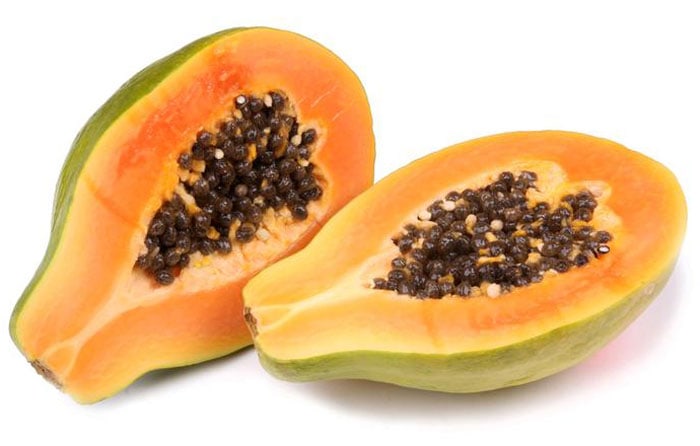
Written By: Sofia Layarda, MPH
Title: Master of Public Health
Alumni: University of California, Berkeley
Last Updated on:

With the onset of warmer weather and longer days, my default is to think up no-cook (or minimal-cook) ideas to minimize time spent in the kitchen. Papaya, which conjures up tropical images of lazy sunsets by the beach, is lovely for many reasons – its soft, sweet, juicy texture makes it perfect as a soothing snack or dessert after a long day playing in the sun. And if you don’t feel like peeling off the skin, simply scoop out the flesh with a spoon!
Table of Contents
1 cup of raw papaya cubes contains:

Along with its soothing, cooling taste, it turns out papaya is a powerhouse of antioxidant nutrients. Just one cup contains more than 100% of the daily value for Vitamin C. It is also high in Vitamin A, folate, potassium, and fiber. The protein-digesting enzymes contained in papaya, papain and chymopapain, have also been shown to lower inflammation and help reduce burns. To top it off, papaya also contains the phytonutrient lycopene; consumption of lycopene-rich foods has been shown to reduce the risk of prostate cancer.
As a tropical fruit variety, papaya comes in many shapes and sizes. The fruit generally has an elongated curvy shape similar to that of a pear that has been stretched out vertically. The Hawaiian papaya can generally fit in the palm of your hand and has a bright yellow or orange flesh. Some of the larger types can be 20 inches long, and have deeper, red flesh. Unripe papaya has a crunchier texture and tart flavor and is a popular ingredient in some Southeast Asian salads. It is sometimes pickled and served as a snack. Interestingly, unripe papaya contains a higher level of papain than ripe papaya, while antioxidant capacity increases as the fruit ripens.
What type of papaya to buy depends on when you intend to eat it. If you are eating it within a day of purchase, buy a fruit that has dark orange patches all over the skin. If you intend to let it sit for a few days, buy one that has yellowy patches alternating with some green areas. Very green fruits are unripe. In all cases, the fruit should feel heavy for its size and have no soft or bruised spots. Flesh that yields to the slightest touch is most likely a bit too ripe and will have a mushy texture. Once sliced, consume quickly since cut-up papayas get soft even when stored in the fridge. If you are thinking of using it in a fruit salad, add it just before serving because it tends to soften all the other fruits.
Alumni: University of California, Berkeley – Sofia believes in bringing back fun and pleasure into everyday eating. She loves cooking, and is constantly experimenting with ingredients, creating recipes and trying them out on family and friends. Her latest interest lies in finding realistic and practical ways of environmentally-friendly food/eating habits.
fruits, grocery aisle, healthy every month, papaya, vitamin c